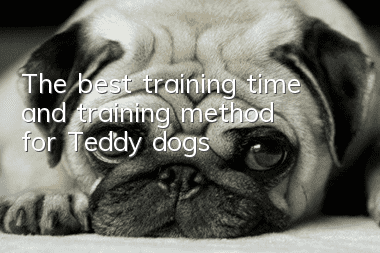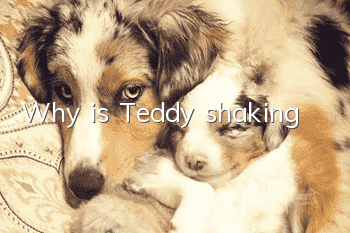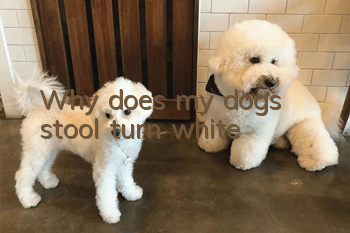The best training time and training method for Teddy dogs

Pets, like people, have the best time to learn, and the same is true for Teddy dogs. Many people also rush to train Teddy dogs during this time, because the training effect is best during this time period, and Teddy dogs can get twice the result with half the effort. Dogs have very high IQs. With guidance and patient training, you can successfully train them into the baby you want. So when is the best time to train Teddy? And how should it be trained?
Teddy
It is best to start training from 4 months
1. "Excretion" training (implemented after meals, the best effect)
In a fixed corner outside the kennel or in the bathroom of the apartment, spread dry newspapers stained with the dog's urine, and then place the newspapers on top. In order to let the dog understand that that is where it urinates and defecates, you have to put a little bit of its excrement [such as newspaper after the urine has dried], because the newspaper has a familiar smell to it. In the early stages of training, the scope of the newspaper should be as large as possible, and then slowly teach it to "solve" it only in the newspaper. Remember to praise it immediately when it does something right; otherwise, reprimand it briefly and firmly. Once the location of the dog toilet is decided, it is best never to move it casually, so as to expand the range of activities of the dog at home. But when teaching puppies, after they are proficient in one action, you need to be patient before teaching the next action... Don't do it too hastily...
2. “No” and “very good” training
When you see your dog behaving badly, you should stop it immediately. And give the [no] command to let it know that this behavior is not allowed and will be scolded by the owner. On the contrary, if the dog has good performance or behavior, you should immediately praise it and give the [very good] command, and stroke its head or neck to let it know that the owner likes this action.
3. "Wait a minute" and "Come here" training
The command "Wait a minute" is to temporarily stop the dog's movement. When eating, place the food in front of the dog, and then give the "wait a minute" command, and train in this way. If you want to train the "come here" action, you can do it while walking. If you call it and come, praise it immediately. If it doesn't come or runs away when you call it, don't get angry and chase it. Let nature take its course and call again later. Try to keep it within a distance of no more than 10 meters from you when it is free to move around. It is very important to develop the habit of rope traction from an early age (*especially when going out to cross the road to avoid accidents~), go to an open place and let it move around freely. If it moves away from you a little, you should call it back and develop a good habit of not straying away from its owner~
4. "Sit down" training-(implemented before meals for the best effect)
When you first give the "sit" command, the dog cannot understand it. You must press down on the back half of the dog's back with your hands, and at the same time give the "sit" command until it understands and sits down quietly. .
5. "Handshake training - (implemented before meals, the best effect)"
Make sure your dog is very familiar with the sit down command and action before implementing it. When it sits down quietly, gently raise your left or right hand and shout the handshake command at the same time. Repeat until your dog understands and listens to its handshake. The password is completed. Training should be repeated every day. When training, remember not to do it too hastily and teach another movement immediately if you are not familiar with one movement. This is the biggest taboo in practical training.
6. "Lie down (lying down)" training-(implemented before meals for the best effect)
If you want to train a dog to lie down, you should find a quiet place. When it has sat down quietly, gently pull its front feet with both hands to form a lying down position. As long as it usually feels that the owner is trustworthy, it will be easy to train. Pat it at the same time. and praise it.
7. "Barking" training
A puppy will wag its tail and act coquettishly no matter who calls it, but the same is true for a large dog, and then it loses its vigilance. This is especially true for playful dogs, which are small in size and lack power. If they are too docile, not only will they not be able to take on the job of looking after the house, but they may even be abducted and lost! In fact, dogs don’t want to bark. If you order them to bark, that’s impossible. , so you need to train before eating. Before each meal, it will always bark excitedly in response to the "bark" and "bark" command. This is very easy to do. If it does not bark and does not respond after repeated commands, you can step on its feet or tail, or walk away. A puppy that is accustomed to going out for walks every day will growl if the owner does not take it out when the time is up. All of the above is nothing more than letting the dog know what action it should take when the owner issues a barking command. Of course, when he calls out, he should be caressed and said yes. Secondly, after the dog is four or five months old, do not allow outsiders to approach at will, so that the dog will become wary of other people approaching at will, in addition to the owner. Or when eating, ask others to come in and grab its food. At this time, the dog will naturally bark.The owner should encourage it by giving "bark" and "bark" commands, and give comfort and rewards to build its self-confidence. It creates trust in the master and rejects others.
8. "Don't bark" and no-bark training
Contrary to the above situation, some dogs like to bark very much, which is really a headache. They also need training. Although this training is opposite to the training mentioned previously, the steps are the same. The main purpose is to let the dog know when to bark. When a guest comes, stop barking. If you pick it up, it will give it the illusion that you just did the right thing. In fact, you should be strict. Say: Don’t bark or hit, so the dog will naturally correct itself. The puppy lives alone in the kennel and is too bored. After barking a few times, you will come from another place. If there is nothing to blame, the dog will think that as soon as it barks, the owner will come immediately. You can also train the dog in the opposite direction before eating. If it keeps barking, you should give the "don't bark" command. Any of the above actions, as long as there is a slight achievement and progress, you should pat the muzzle next to the mouth to show your approval.
9. "Go in" training
The purpose of "go in" is mainly to order it to enter the dog house. At the beginning, use the pull strap or hand to force it in, and at the same time give the "get in" command. Especially before going to bed at night and when you return from exercise, you can repeat it multiple times a day until you learn it. One thing that must be noted is that the location of the dog house should not be changed frequently to avoid confusion for the dog. After you have learned the movement of going in, you can try to do it without pushing it with your hands, and just give the command to do it. Then change the position, point out the direction with your finger, and command it to be in place. The above training actions are first mandatory, and then each command is followed by an action, with clear rewards and punishments. If it is a dog that loves to play indoors, the method is the same. If there is a dog house, it should be made to enter the dog house or sit in a specific place. place to show obedience.
10. "Opening your mouth" training
Opening your mouth training is not difficult. First of all, you must establish the confidence that "opening your mouth does not cause any loss, but actually benefits you." Based on this confidence, you should first approach the dog's body, caress it to settle down, move your palms from the head, forehead, and then to the upper forehead muzzle, and try to lift the upper forehead muzzle upwards with the tiger's mouth. If it is resisted, When it happens, you should put it down immediately and praise it with "good" and "good". After a while, try it again.Give it a try. If the dog still closes his mouth and does not open his mouth, you should wait patiently and do not use unreasonable violence to avoid self-defeating. "While opening the upper muzzle, also open the lower muzzle." The owner immediately puts a piece of something the dog likes to eat, such as pieces of meat, biscuits, etc., into the dog's big mouth. If he goes back and forth several times, the dog will feel that opening his mouth is quite beneficial to him, and then the training will be successful. . It will also be much more convenient when feeding medicine in the future (grab the chin and stuff it deep into the throat). This training can be tried several times until the owner lifts the muzzle and opens the lower muzzle at the same time. To learn this kind of training, you don’t have to spend too much time. If you repeat it a few times, the dog will remember it. Even for a very forgetful dog, three days is enough.
11. “Don’t throw yourself” training
When a dog sees its owner coming back from going out, it happily jumps on it. The owner may not like it at this time, but how should it be handled? In principle, it is prohibited. If it is not corrected when it is young, the dog will instinctively behave in this way. A straightforward and emotional way to show its inner happiness. If you want to prohibit this behavior, there are two ways. The first method is that when you come back from an outing, it pounces on you or your legs, and when it raises its front legs or looks happy, you use your feet to trip its back legs, or step on its back toes. It will feel the pain and give up, and then it will start again soon. You should prepare it according to the method and try it again to make it feel that this method is not working. The second method is when it jumps up, you grab its front toes with your hands and hold it hard. It will feel the pain and give up. The main purpose is to make it associate the feeling of jumping forward with the pain. . After completing the above two methods, the owner can immediately order it to sit down. If it is successfully achieved, gently pat it on the head to show appreciation. As a result of such repeated training, the dog will feel like jumping on the owner. Instead, it is better to sit down and wait for the owner's caress. As the owner, of course you are not stingy in giving caress and praise.
12. “Don’t bite” training
Sometimes dogs bite furniture and trouser legs. You should stop them in person and say no, or spank them. There is a reason why dogs like to bite things. When they are puppies, they are full of curiosity about the things around them. They treat objects as playmates. They lie down with their forelimbs forward, which is an inviting posture. Secondly, at 3 to 6 months after birth, when the deciduous teeth are about to transform into permanent teeth, puppies especially like to bite things, and their gums become itchy, resulting in a physiological desire. The third point is that a puppy with strong growth potential has too much energy and nowhere to use it, especially a puppy in the growing period.
In addition to the methods of strong punishment and spanking, you should also review:
(1) Enter the houseFrom now on, restrict it from playing in the kennel and sports ground.
(2) Choose toys for it to play with, such as commercially available fake bones made of cowhide, hard balls, or things that are no longer used (dolls, shoes, etc.).
(3) Increase walking time and amount of exercise outside.
(4) During this biting time, put movable objects up or put them away. A puppy that has no biting habit at all is either sick or has a bad temperament. As long as it is good at stopping biting, it can still be taught. At the same time, transfer its abundant energy to training, and it will be beneficial. You can try it.
13. "Correction of biting habit" training
Dogs have a natural tendency to be nosy, such as chasing moving things. This phenomenon is especially noticeable when puppies are young; if this phenomenon is not prohibited, it will also lead to neurosis, so it should also be trained together. In order to achieve the purpose of training, you can take it to animals that are weaker than it. Lure it and see if it wants to get close. Stop it immediately with a "no" or beat it, and pull it back with a drawstring. Follow this method and try again. Let it know why the owner is dissatisfied. In case of a little bird Or when the goldfish has been killed by it, you should push the dog’s head to the carcass and let it smell it before beating it so that it understands why you are displeased before you scold it or hit it. Others such as outside the window The same method is used for potted plants, flowers and trees, etc. In addition, some small dogs will bite the heels of visiting guests. Such puppies are usually fearful and protective in character, so they should be prevented as soon as possible. Dog bites The harm is relatively minor, and you need to train it carefully at this time. Only when it grows up can you safely take it out without danger. Otherwise, it will be too troublesome to wear a mask on the road. A dog that is often kept in a dog cage or tied up , whose movements are controlled for a long time, can easily lead to physical and mental imbalance, which will lead to the emergence of biting habits. The owner will neither take it out nor play with it, especially if it is not used to people and objects in the outside world. Once a stranger approaches, it will always bite. If you think you are going to harm it, it is better to strike first. If a person is imprisoned in a small world for a long time, his body and mind will become abnormal. This principle is the same for dogs.
14. "Follow up from side to side" training
The action of walking on the left side with your dog beside you and following up may seem easy, but in fact it still requires some teaching. This kind of training is very important. Cities are very densely populated with people and vehicles, and if they are allowed to run around, dangers and car accidents can easily occur. At the beginning of training, use a short strap to pull the left side of the body. At this time, the strap should not be placed too long to allow it to move freely. After six months, strict training will be implemented to cultivate the habit of side walking and follow-up from an early age. Once the habit is developed, the straps will be gradually lengthened or no straps will be used at all.[i.e. the cordless foot left follow-through in an advanced move]. If you encounter a situation where the dog is ahead during the training, you should pull it back immediately. If it refuses to go, then forcefully pull it away. A kind of thorn collar can also help you complete the training. The third situation is that the dog is too far away from its owner. You can use the edge of a drainage channel or a fence to train it. Since there is a risk of falling in the ditch, it will naturally have to move close to the side. Rewards and punishments should be used alternately during training, but it is not easy to create a mentality that treats walking as a fear.
- What causes yellow urine in dogs?
- Why is the Teddy dog lame inexplicably? A must-read for pet owners!
- 4 solutions to dog constipation
- Causes of bloating in pets
- Why do dogs grind their teeth?
- Causes of canine brucellosis | Diagnosis | Prevention and treatment methods
- What are the signs of pregnancy in dogs?
- What should I do if my Shiba Inu is picky? How to correct the picky eating behavior of Shiba Inu?
- What to look out for when buying a pug
- How to correct these bad behaviors in dogs



